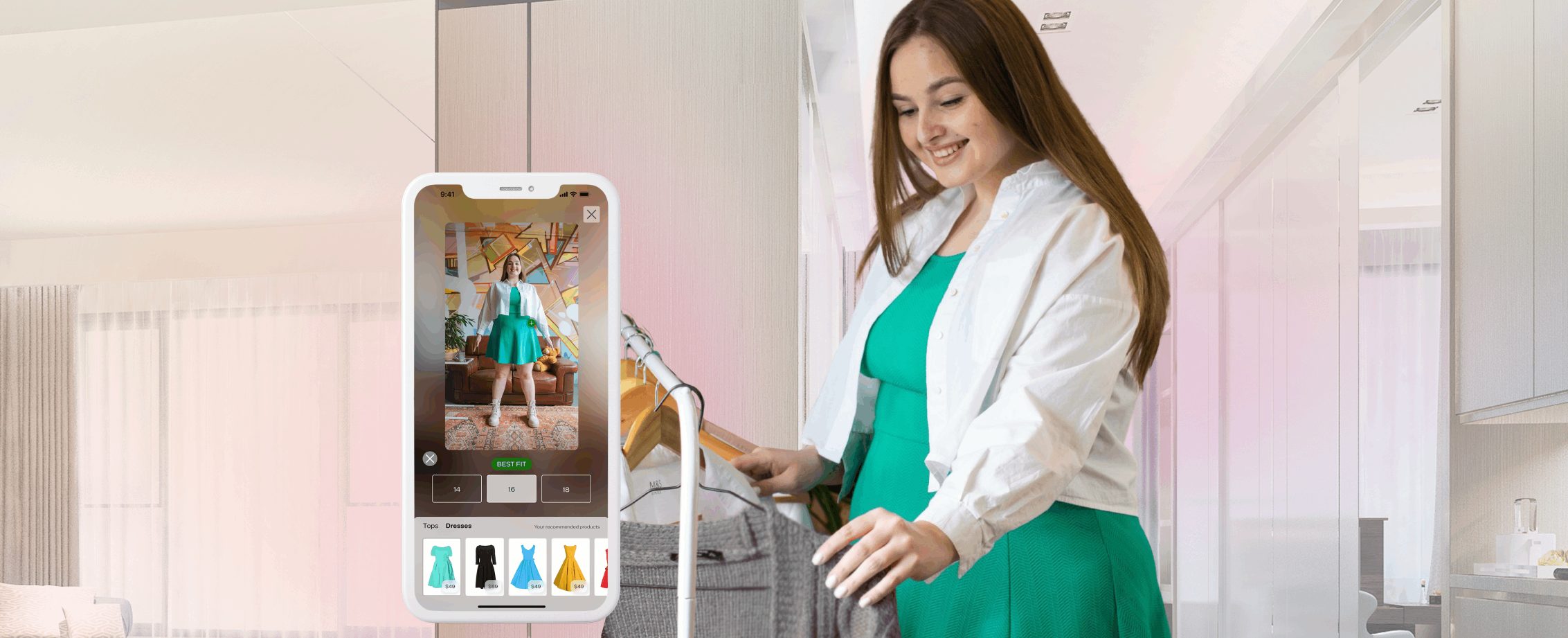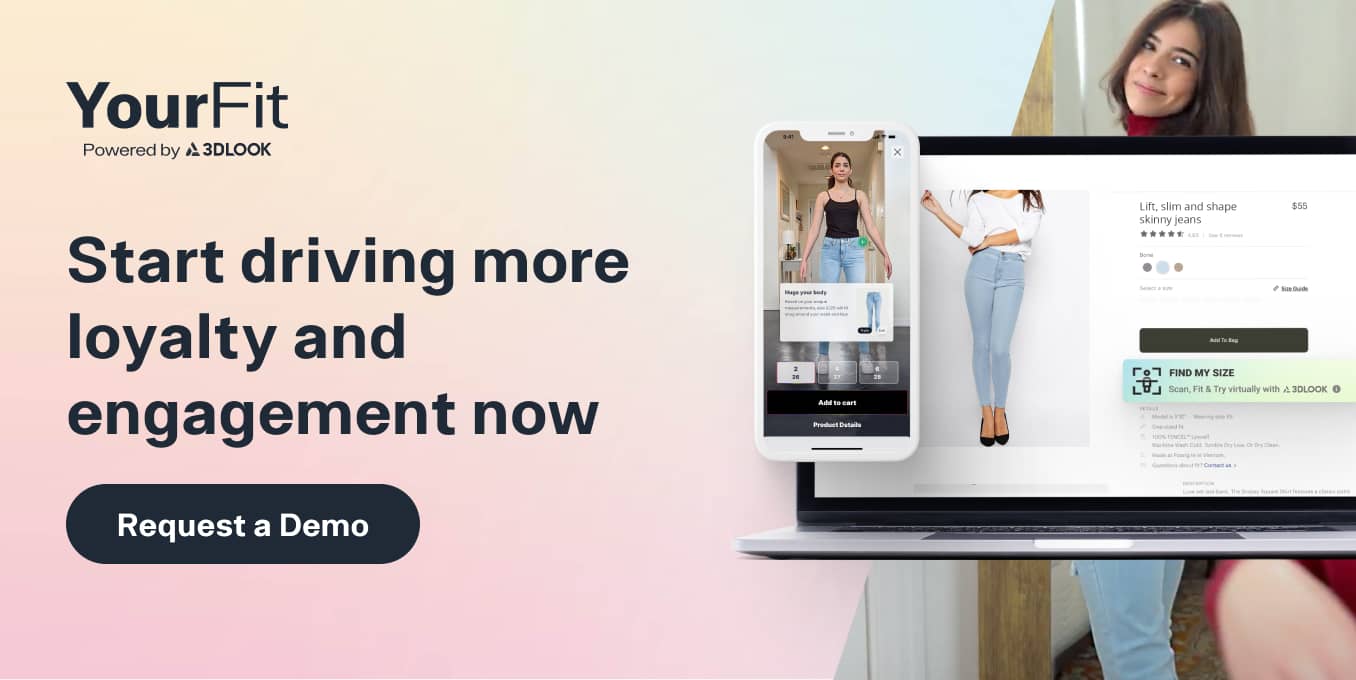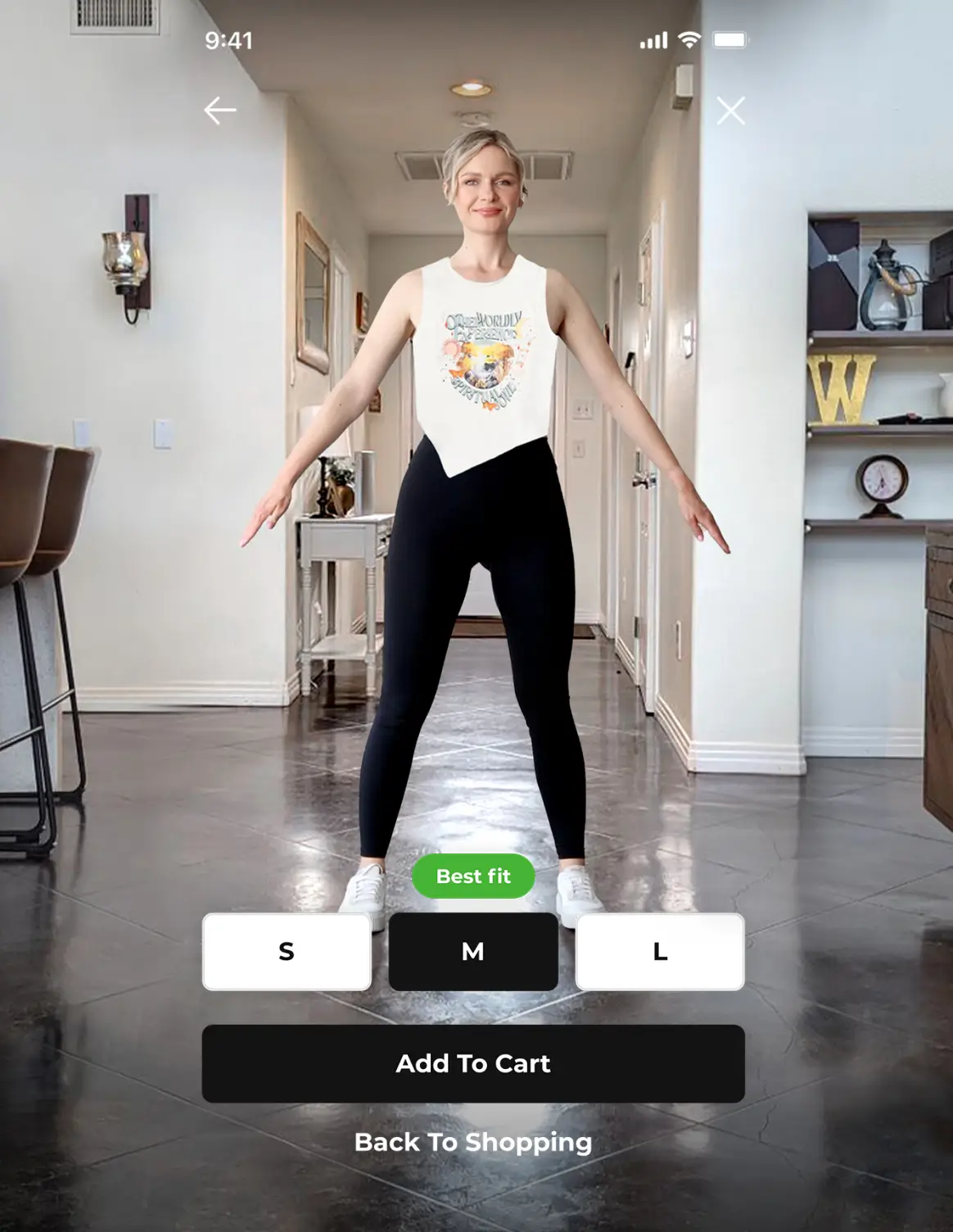Adopting a virtual fitting room for eCommerce alleviates customers’ concerns while also providing businesses with a range of competitive advantages. Learn how brands can improve customer satisfaction while increasing sales by implementing a single solution.
Customers have always feared purchasing clothes online because their apparel might not fit. Since the early 2010s, various companies have been working to develop a solution to tackle customer concerns while also providing a more engaging shopping experience.
With the rapid technological advancements of the past decade, innovative sizing solutions have materialized. Among the innovations are virtual fitting tools, which utilize augmented reality and artificial intelligence to recreate the dressing room experience digitally.
As well as addressing customers’ sizing concerns, these solutions can also help brands meet their inclusivity and sustainability goals while driving greater business performance — unsurprisingly, virtual fitting rooms are fast becoming a must-have for fashion retailers.
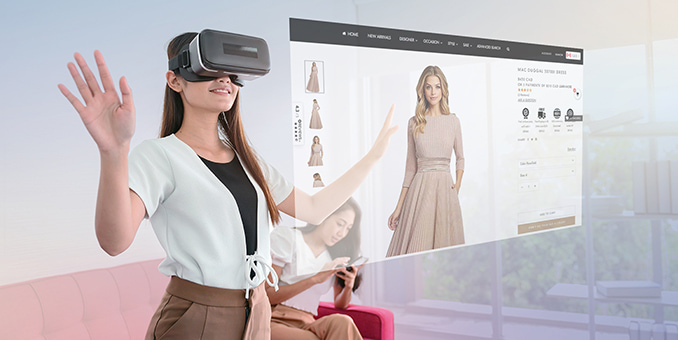
What is virtual fitting room technology, and how does it work?
A virtual fitting room is the digital version of an in-store dressing room, where customers can try on a product virtually to visualize how it may look on their bodies, and evaluate features such as color, pattern, and style before purchasing.
Today, a number of virtual try-on solutions exist. These typically rely on a combination of artificial intelligence, computer vision, and augmented reality. However, not all virtual fitting technology produces the same results or has the same impact on the customer experience.
The various types of online fitting room software
Some virtual dressing room software focus on providing the customer with a complete view of a brand’s products in various styles and sizes through 3D renders. Typically, these solutions allow customers to view the clothing on a digital mannequin with a similar body to their own (by selecting weight and height, for example). Others take a similar approach but allow the customer to choose from various human models that vary in shape, size, and appearance. These solutions make it easier for the customer to visualize how an item fits the human body but fail to consider that no two bodies are the same.
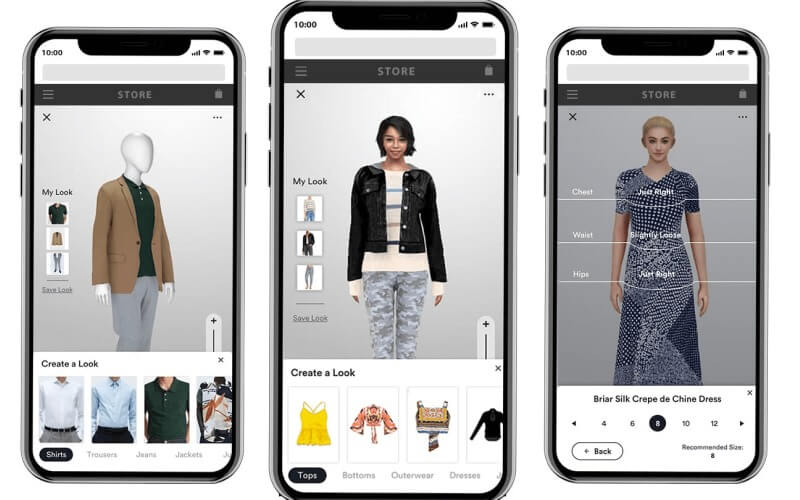
To overcome this, some 3D virtual fitting solutions encourage customers to enter a number of body measurements and shape selections to create a personalized avatar. Yet, manual measuring introduces the risk of human error and subsequently results in avatars that do not truly reflect the customer’s body.
Others use AR technology to render virtual clothing on top of the customer’s body in real-time through a mobile device. While this helps customers visualize how the garment looks on them, it neglects a key use of the fitting room: to know whether a garment will fit right.

What customers really desire is a solution that doesn’t just show how a garment will look or how a garment will fit. Instead, they want a virtual fitting room that does both, providing the same experience as a physical fitting room. Likewise, with 73% of consumers expecting personalized shopping experiences, according to Salesforce, they don’t want to dress up a model or mannequin with whom they share a resemblance. Rather, they want to see themselves – with their look and shape genuinely reflected in the virtual fitting room.
YourFit by 3DLOOK is the only solution that provides a photorealistic try-on experience tailored to each customer. Unlike alternative solutions, which provide avatars with similarities or overlay images on live video, YourFit instantly generates a unique 3D avatar and over 86 points of measure from a quick scan on a shopper’s mobile device. This is then mapped to the brand or retailer’s product data and delivers a highly visual fit experience while removing the complexity of figuring out what size to buy. This offers everything customers desire from a virtual fitting room: A reliable sense of how a garment will look and fit their unique body, the confidence to complete a purchase, and the highest level of personalization.
Virtual fitting room software early adopters: What companies use virtual fitting rooms?
Many popular fashion brands are already capitalizing on online fitting room solutions.
Luxury fashion brand Gucci introduced an AR virtual dressing lens for Snapchat in 2020, allowing customers to see how the brand’s sneakers would look on their feet. With an integrated ‘shop now’ option to direct users to the brand’s product pages, Gucci makes the purchasing process easier for customers while also providing an engaging shopping experience.
However, this only scratches the surface of what is possible using 3D virtual fitting technology. To enhance its technology, Snapchat has continued to invest heavily in the virtual fitting room app market, acquiring several startups including Fit Analytics and Screenshop.
Likewise, Walmart acquired the virtual fitting room platform Zeekit and AR virtual dressing technology startup Memomi to expand the capabilities of its own virtual fitting solution. Working with retailers like ASOS and Adidas, Zeekit has developed technology that lets buyers digitally try-on items before buying. Zeekit creates a virtual body model based on a customer’s photos and measurements they can then dress accordingly.
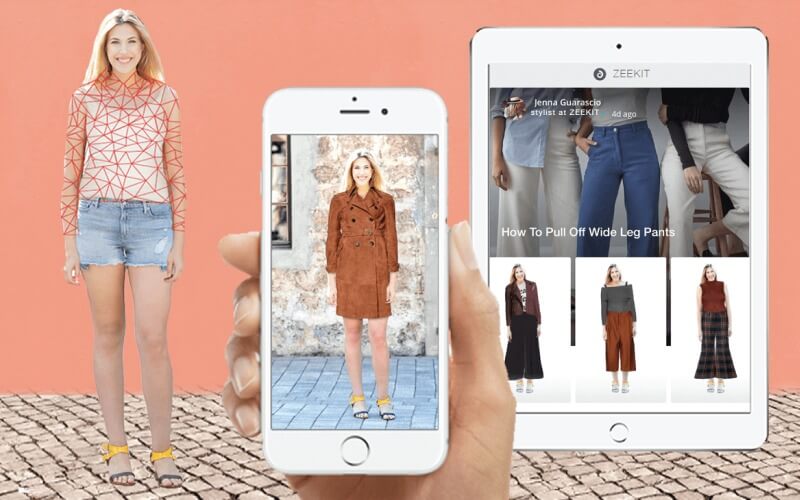
Apparel retailer Gap acquired eCommerce startup Drapr, which uses 3D virtual fitting technology, in August 2021. The startup’s technology enables customers to create 3D avatars of themselves to try on clothing.

Virtual fitting room – a solution for both online and on-site fashion retailers
However, virtual fitting is not exclusively for online stores; it can also significantly improve the in-store shopping experience. Ralph Lauren, for instance, installed virtual mirrors in its in-store fitting rooms. Cameras embedded in the mirrors utilize Oak Labs’ RFID technology to determine which products a shopper has brought into the fitting room. This data is combined with product information such as available sizes and colors to offer additional product recommendations. Ralph Lauren claims that its virtual mirrors have a 90% interaction rate. Thus, the brand is collecting abundant data from its online fitting room software to fine-tune its retail strategy and improve business performance.
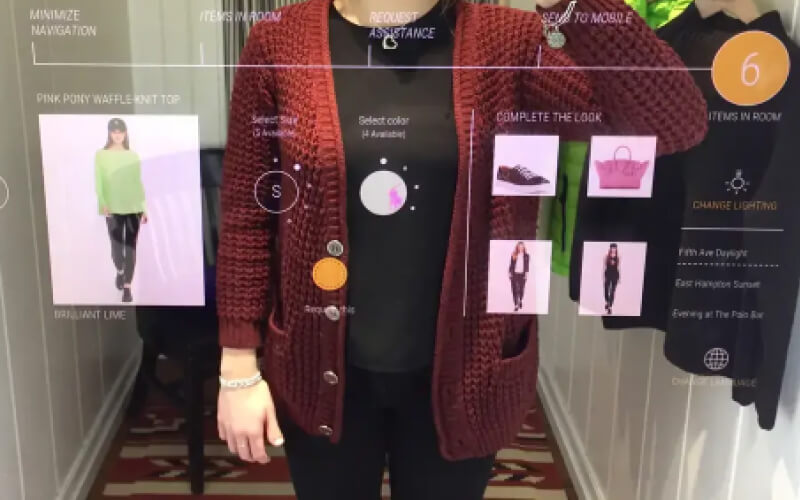
YourFit by 3DLOOK supports retailers both online and in-store, while (as the first and only on the market that combines photorealistic try-on with precise size recommendations to offer customers their own personal virtual fitting rooms) providing consumers with a superior shopping experience. Using YourFit, brands have dramatically improved their conversion, sales, and return rates.
Request a DemoWhat are the benefits of a virtual fitting room for eCommerce?
Implementing try-on technology has a myriad of benefits for retailers. According to Shopify, customers who used augmented reality software, such as virtual dressing rooms, to try on clothing were 40% less likely to return the item.
Boosting sales
With a virtual dressing room, retailers can help customers figure out their best size, fit, color, and style, increasing their shopping confidence and encouraging them to complete a purchase. Likewise, customers have the freedom to explore variants, customize products to their taste, and try on numerous products in a fraction of the time.
According to Valuated Reports, the global virtual fitting room market is likely to grow from 3 million dollars in 2019 to 6.5 million dollars by 2025. What this means for fashion ecommerce brands is significant revenue and business growth, especially for those with virtual fitting rooms already implemented.
Not only does this engaging experience encourage immediate sales, but it can also boost customer loyalty that drives repeat purchases. Unsurprisingly, retailers have been able to quadruple their sales and boost average order value by as much as 20% using virtual try-on technology.
Providing diverse experiences
Using personalized virtual models enables businesses to provide more inclusive and diverse shopping experiences to their customers. For instance, shoppers can choose a digital model with a skin tone, size, and body type similar to their own within the space of a virtual dressing room.
However, retailers can take personalization and inclusivity to the next level with an AI 3D virtual fitting solution. These tools enable customers to see how a product looks not simply on a body model they share a likeness with but on a model created from their own, unique body data. With many let down and left out by a lack of diversity and inclusivity in fashion, retailers shouldn’t underestimate the profit-making potential of a truly personalized virtual try-on experience.
Reducing return rates
One of the biggest problems for fashion retailers is the ever-growing number of returns. Returns create hassle and cost money, especially if you offer a free return policy. According to a Narvar report 42% of all eCommerce returns are due to the product being too small or too large in size.
Providing an online trial room for clothes can assist retailers in resolving the problem of poor fit and eliminate the bracket shopping trend. It allows shoppers to view how an item looks on their bodies without even putting it on, so they know what to expect once it arrives at their door.
With a size recommendation solution aimed at matching customers with their best size and fit, retailers can overcome sizing issues before customers complete their orders. The most effective virtual dressing room software compares each customer’s precise body data against product data to determine the ideal option for them — helping retailers avoid up to 10% of returned sales.
Providing customer convenience
Convenience is the foundation of an outstanding eCommerce experience and a significant cause of online shopping’s recent growth. On the other hand, inconvenient processes can put shoppers off. In fact, according to Smart Insights, 97% of consumers abandon purchasing due to a lack of convenience when shopping online.
Clothing, in particular, has one of the highest abandonment rates of any product page. According to Convertcart, concerns over the product’s fit are to blame 30% of the time. To find the right size, customers must consult complex sizing charts that vary drastically from retailer to retailer or request the support of a customer service agent. This is hardly the convenient experience shoppers turn to eCommerce for.
What they really desire are virtual dressing rooms, which can remove the complexity of sizing from online shopping entirely.
Virtual fitting room technology, such as YourFit, is making it simple for customers to determine whether a product would look good on their bodies. In a matter of seconds, they can scan themselves, the virtual fitting technology produces a tailored recommendation, and they can see exactly what they can expect once the product arrives at their door.
Creating omnichannel experiences
As well as improving the eCommerce experience, virtual try-on technology can bring the convenience of online shopping to the physical store and help brands create the cohesive experience customers desire.
Amid the pandemic, retailers implemented various safety measures and looked to virtual dressing rooms to replace the traditional fitting room experience. This came in the context of customers shifting to a safer shopping experience where the reluctance to try on clothes in brick-and-mortar fitting rooms was very high. While safety concerns have seemingly faded – with retail sales having surged in early 2022 – demand for these high-tech features remains. More than 70% of millennial shoppers want to see online shopping features implemented in stores, with virtual fitting room technology among the innovations most likely to drive in-store conversions, according to Accenture, while two-thirds of Gen Z shoppers would like to use their smartphones at various points throughout the physical shopping experience.
Thus, today, a virtual fitting room is the right innovative solution for fashion retailers to satisfy all types of customers.
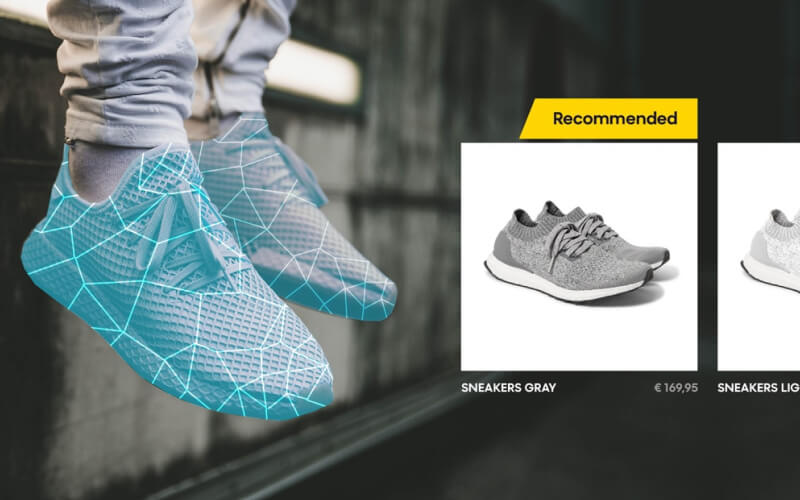
Getting deeper analytics
Virtual fitting technology can play a crucial role in driving conversions, but the right tool could also help brands acquire data about their customers and the products they buy.
Virtual fitting rooms such as 3DLOOK’s YourFit, which uses body scanning technology to extract each customer’s unique body measurements, offer retailers an abundance of anonymized data. With this, retailers can tweak their dragging rules, improve distribution, tailor marketing campaigns, and design future products according to the needs and preferences of their most loyal customers.
Fostering a positive brand image
According to Context Consulting, half of the young shoppers prefer greater technology use in retail over lower prices.
It’s already a well-known fact that before buying, many shoppers conduct online research. Enhancing dressing room experiences to be personalized, inclusive, and engaging can assist retailers in converting these “casual browsers” into customers.
Hence, a virtual fitting room is quite a boon for online clothing retailers as it can help them attract loyal customers to their brand.
By introducing a virtual fitting room for eCommerce, your customers will perceive your company as more innovative and customer-focused than your competitors, giving you a competitive advantage. Additionally, when you mix such innovative initiatives with an advanced marketing strategy, your brand’s potential for growth increases enormously.
Is there a future for virtual fitting rooms?
An increasingly competitive market is driving retailers to find innovative ways to get ahead, and virtual fitting rooms are a viable option for retailers – big and small – hoping to improve business performance and encourage consumer engagement.
According to McKinsey, digital, sustainability and consumer engagement – which represent the desires of young consumers – present the three biggest opportunities for fashion businesses. Implementing 3D virtual fitting room software can help retailers meet all of these desires.
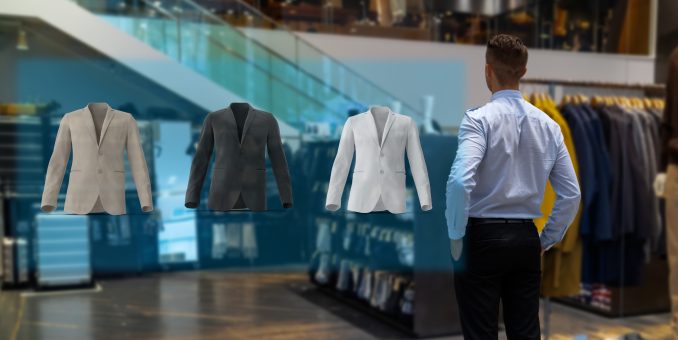
What results can fashion retailers achieve by unlocking the virtual dressing room?
Not all virtual dressing rooms are created equal and the results will vary drastically depending on the solution a brand implements. However, virtual dressing rooms that meet both the needs of consumers to see how a product looks and how it fits before they purchase can have a significant impact on a number of important retail metrics.
For instance, using YourFit, brands have been able to boost their average product page views and session length by up to 300%. Providing customers with the confidence to shop without worrying about size and fit, its personal virtual fitting rooms are able to increase AOV by as much as 25%, while conversion rates grow by 13-16% on average.
Virtual fitting rooms can also dramatically reduce returns. YourFit customers see a 3-6% decrease on average, but the results are often far greater. By opening the doors to 3DLOOK’s personal virtual fitting rooms, shaping swimwear brand TA3 SWIM was able to cut its size-related returns by almost half, to just 9%, over a six-month period.
Customers don’t want a virtual fitting room app. They want a personalized fitting platform – and a complete solution is just a few clicks away.
But the success of an online fitting room implementation will depend on how well it meets consumers’ needs. For instance, a virtual fitting room app that merely maps a product image over the customer’s body won’t enlighten customers on how a product will fit their body – which is crucial to the virtual fitting experience. Thankfully, the market offers a complete, ready-made solution that can be easily integrated into a brand’s existing eCommerce ecosystem: YourFit by 3DLOOK.
As the first personalization solution to combine virtual try-on with size and fit, users get both the option to try on clothes virtually, as well as personalized recommendations for the clothing they’re interested in and which fits them. YourFit also includes an exciting social sharing feature, enabling users to share their try-on experience with their friends and followers through any social app. As well as encouraging social proof that increases a customer’s confidence, promotes brand re-engagement, and brings new shoppers back to the brand’s website as a form of customer acquisition.
With consumer wants and expectations evolving, now is the right time for brands and retailers to explore and deploy innovations such as virtual fitting rooms, which promise exciting benefits for both retailers and consumers.
Request a DemoFurther reading:
AR clothing try-on: Who benefits and how?